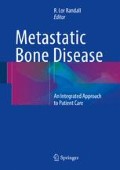Abstract
Metastatic adenocarcinoma to the tibia can be a complicated problem that may be difficult to manage. However, reasonably good functional results are possible when managed with an appropriate team of cancer care professionals with a treatment algorithm tailored for each individual patient. Metastatic disease to the tibia is historically seen at later stages in the primary disease process; certainly more so than that of the proximal femur, the humerus, and the axial skeleton. Standard treatment protocols and algorithms for tibial disease are less specifically defined compared to those of the other appendicular long bones, and as such, the data are limited given short-term follow up, and the lower frequency of problems related to tibial disease. However, given improvement in medical therapy, alternative methods of stabilization, and megaprosthetic modularity, quality of life and function can be preserved with an appropriately aggressive algorithmic approach to this site of disease.
Access this chapter
Tax calculation will be finalised at checkout
Purchases are for personal use only
References
Landis SH, Murray T, Bolden S, Wingo PA. Cancer statistics, 1998. CA Cancer J Clin. 1998;48:6–29.
Coleman RE. Clinical features of Metastatic bone disease and risk of skeletal morbidity. Clin Cancer Res. 2006;12(Suppl 20). Accessed 15 Oct 2006.
Rock MG. Metastatic lesions of the humerus and the upper extremity. Instr Course Lect. 1992;41:329–33.
Kelly CM, Wilkins RM, Eckardt JJ, Ward WG. Treatment of metastatic disease of the tibia. Clin Orthop Relat Res. 2003;415S:S219–29. Lippincott Williams and Wilkins, Inc.
Coyler RA. Surgical stabilization of pathologic neoplastic fractures. Curr Probl Cancer. 1986;10:117–68.
Leeson MC, Mackley JT, Carter JR. Metastatic skeletal disease distal to the elbow and knee. Clin Orthop. 1986;206:94–9.
Baston OV. The function of the vertebral veins and their role in the spread of metastases. Clin Orthop. 1995;312:4–9.
Mirels H. Metastatic disease in long bones a proposed scoring system for diagnosing impending pathologic fractures. Clin Orthop 249: 256–264, 1989.
Geeter KD, Reynders P, Samson I, Broos PLO. Metastatic fractures of the tibia. Acta Orthopaedica Belgica. 2001;67:1.
Coleman RE, Lipton A, Roodman D, Guise TA, Boyce BF, Brufsky AM, et al. Metastasis and bone loss: advancing treatment and prevention. Cancer Treat Rev. 2010;36:615–20.
Coleman RE. Metastatic bone disease: clinic features, pathophysiology and treatment strategies. Cancer Treat Rev. 2001;27(3):165–76.
Clohisy DR, Plaker D, Ramnarine MLE, Pekurovski I, Oursler MJ. Human breast cancer induces osteoclast activation and increases the number of osteoclasts at sites of tumor osteolysis. J Orthop Res. 1996;14:396–402.
Body JJ, Bartl R, Burkhardt P, et al. Current use of bisphosphonates in oncology. J Clin Oncol. 1998;16:3890–9.
Coleman RE. Metastatic bone disease and the role of biochemical markers of bone metabolism in benign and malignant diseases. Canc Treat Rev. 2001;27:133–5.
Pearse RN. New strategies for the treatment of metastatic bone disease. Clin Breast Canc Vol 8, Suppl 1. Dec 2007.
Hortobagyi GN. Moving into the future: treatment of bone metastases and beyond. Canc Treat Rev. 2005;31:S9–18.
Eccles SA, Welch DR. Metastasis: recent discoveries and novel treatment strategies. Lancet. 2007;369:1742–57.
Kanis JA. Bone and cancer: pathophysiology and treatment of metastases. Bone 1995;17(2):101S–5S.
Sumathi VP, Jeys L, Legdeur N. Metastatic tumours of bone. Surgery. 2011;30(2). pgs 80–85 Elsevier.
Pakos EE, Gartzonikas DN, Tsekeris PG, Xenakis TA. Solitary tibial osteolytic lesion. Case Rep Med. 2009, Article ID 352085.
Author information
Authors and Affiliations
Corresponding author
Editor information
Editors and Affiliations
Rights and permissions
Copyright information
© 2016 Springer Science+Business Media New York
About this chapter
Cite this chapter
Webber, N.P. (2016). Metastatic Bone Disease:Femur—Tibia. In: Randall, R. (eds) Metastatic Bone Disease. Springer, New York, NY. https://doi.org/10.1007/978-1-4614-5662-9_25
Download citation
DOI: https://doi.org/10.1007/978-1-4614-5662-9_25
Publisher Name: Springer, New York, NY
Print ISBN: 978-1-4614-5661-2
Online ISBN: 978-1-4614-5662-9
eBook Packages: MedicineMedicine (R0)

